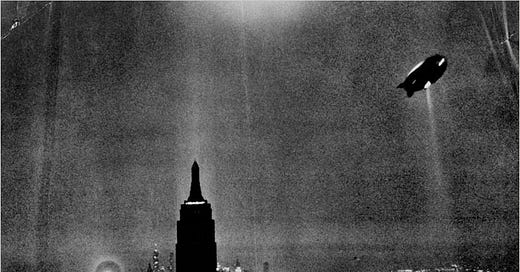The Gernsback Continuum: Gibson Closes a Door
I collect stories. Not just any stories, I collect semiotic phantoms—bits of cultural imagery that were once part of the mass consciousness but are no more. You can thank William Gibson for the phrase—semiotic phantom, or semiotic ghost. You can find it in his story, “The Gernsback Continuum” first published in the anthology, Universe 11 in 1981.
“The Gernsback Continuum” is an early story for Gibson, coming out the same year as “Johnny Mnemonic.” It is important as it signals the beginning of the cyberpunk era. But more importantly for me, it signals a switch from one reality path to another. The former— a humanist future—is replaced (or, overwritten) by a transhumanist dystopia. Was this Gibson’s personal vision? Or, was he part of a bigger movement including news and publishing, to move the ship of culture onto a new and darker path?
Let us assume the latter, for the moment. If this is so, than all of the humanist stories from the 1930’s would need to be forgotten. Especially, the speculative and science fiction. Why? Because it is on the backs of these stories that greater childhood dreams can be built.
Remember the stories of how original Star Trek episodes inspired kids to grow up and become scientists? Well, that started back in the 1920’s, coincident with the arrival of science fiction in its current form. The man behind that movement was Hugo Gernsback and that’s why the story is named after him.
In “The Gernsback Continuum” a photographer is hired to shoot images for a book about 1930’s art deco—The Airstream Futuropolis: The Tomorrow That Never Was. The deeper he gets into the assignment, the more the photographer resonates with the subject. Eventually, he starts seeing into that other reality as if it were real. In this alternate, the future has progressed from ideals for mankind as they were thought of in the 1930’s.
“The Thirties dreamed white marble and slip-stream chrome, immortal crystal and burnished bronze.” These were the impossible images drawn by Frank R. Paul and Alex Raymond. Flash Gordon cities and Flash Gordon people. And this is the other place that begins to overlap our photographer’s reality.
He doesn’t like it and goes to see a writer friend who tells him about “…semiotic phantoms, bits of deep cultural imagery that have split off and taken on a life of their own…." The imagery that the photographer sees, the writer explains, was once part of the mass consciousness and he’s started to pick up on it.
The final straw comes for the photographer when he wakes to see two people from that alternate reality standing but few feet away. Before them is an alternate Tucson… “ the city….[with] zeppelin docks and mad neon spires... Spire stood on spire in gleaming ziggurat steps that climbed to a central golden temple tower ringed with the crazy radiator flanges of the Mongo gas stations….Roads of crystal soared between the spires, crossed and recrossed by smooth silver shapes like beads of running mercury. The air was thick with ships: giant wing-liners, quicksilver little darting silver things...mile long blimps, hovering dragonfly things that were gyrocopters...."
He calls his writer friend and demands help before he goes mad. The writer tells him not to worry about it and gives him a cure. “Watch lots of television, particularly game shows and soaps. Go to porn movies...I'm letting you in on a trade secret: really bad media can exorcise your semiotic ghosts."
The photographer puts himself onto a heavy diet of mainstream media and pornography. And it works, the other reality starts to fade. I find the final lines of the story particularly interesting. While buying his daily packet of newspaper tragedies the news seller comments, “Hell of a world we live in, huh? But it could be worse…” Our photographer responds, “That's right...or even worse, it could be perfect.”
So are we to take this all at face value? I don’t think so. We have just witnessed a switch track in the history of science fiction. Although it had been dying for several decades at this point, the Gernsback continuum still had a bit of life left in it. Not much, but somewhat. Gibson tells us that the new road for humanity is transhumanist, dystopian, and ugly. There is no more place for the alternate, for perfected humanity.
I should mention at this point that I don’t believe the “slipstream chrome” world as described in the story is any more ideal than the cyberpunk reality. What I do think is that it was human-centric. I know that cyberpunk is not.
So what about this Gernsbackian alternate? In this substack we will open up a door and examine some semiotic ghosts from that past era.
This is the Rocketeer signing off for today.





